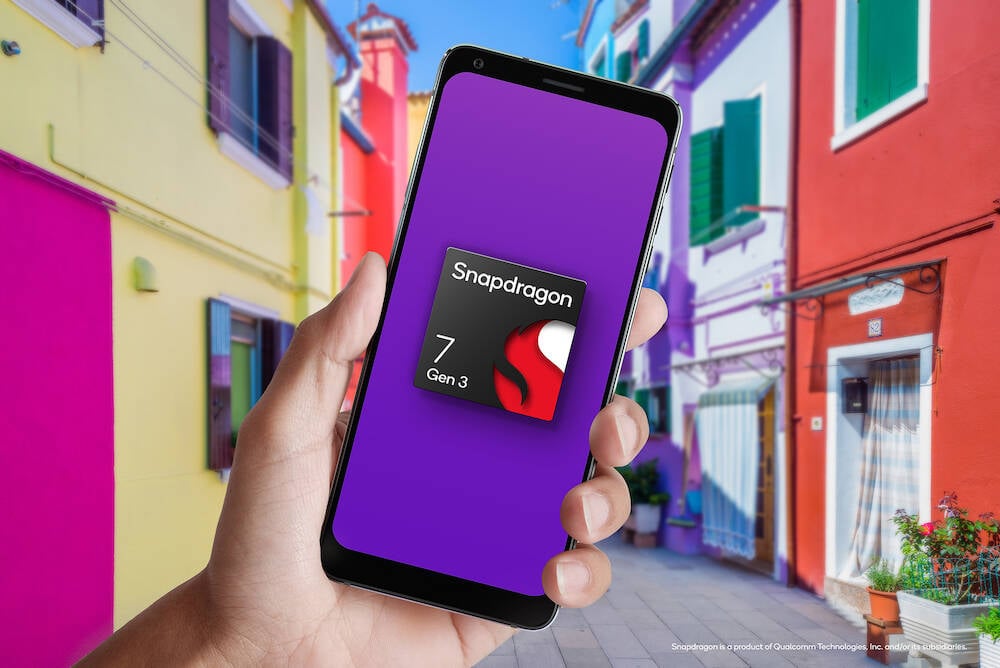Qualcomm Promises 'premium Performance' In Gen 3 Snapdragon 7 Phone Chips

Qualcomm has lifted the lid on its Snapdragon 7 Gen 3 series of mobile processors, which is intended to bring “premium performance” to smartphones at a lower price point than top-end components.
The US semiconductor giant claims its latest silicon delivers across-the-board advancements in on-device AI, gaming support, camera and 5G connectivity. It has already been adopted by phone makers such as Honor and Vivo, Qualcomm said, with the first device based on the silicon expected to be announced this month.
The Snapdragon 7 series is Qualcomm’s so-called “high tier” smartphone platform, targeting handsets in the $400 to $600 range. That makes it a step down from the “premium” Snapdragon 8 series, but sitting above the Snapdragon 6 and Snapdragon 4, which target mid-range and budget devices, respectively.
However, the chip house likes to claim that it is infusing “premium” features into new releases of its lower tier products, and in this case those are said to include better camera capabilities, 15 percent better CPU performance, and 50 percent better GPU performance compared to the first Snapdragon 7 generation.
A glance at the specs of the third generation shows that the Kryo CPU block in this platform sports a single 2.63 GHz Arm Cortex-A715 prime core, three other A715 performance cores at up to 2.4 GHz, and four Cortex-A510 efficiency cores at up to 1.8 GHz.
This is a similar 1-3-4 arrangement to the Snapdragon 7+ Gen 2, but at a lower speed. Qualcomm hasn’t detailed the specific GPU, though online rumors pointed to it being the Adreno 720 design, a step down from the Adreno 725 in the previous product.
- Want a well-paid job in tech? You just need to become a cloud-native god
- Qualcomm and Iridium's satellite link-up loses signal
- Late Qualcomm cofounder teleports $200M into SETI to bankroll hunt for alien life
- Google formally gets to work on Android on RISC-V
Qualcomm’s GM of mobile handsets Christopher Patrick claimed in a statement that the latest platform is designed to deliver a better balance of performance and power efficiency, leading to a better experience for users.
For example, better CPU and GPU performance is said to enable 20 percent overall power savings, presumably versus the first generation, while the Adreno Frame Motion Engine is claimed to be able to double frame rates to upscale graphic content while maintaining the same power consumption.
Qualcomm also claimed that triple frequency location support new in the Snapdragon 7-series provides greater location accuracy.
The cellular subsystem is the Snapdragon X63 5G Modem-RF System, which is said to offer 5G download speeds of up to 5Gbps, plus support for 5G/4G Dual-Sim Dual Active (DSDA), which allows the use of two simultaneous SIMs.
The FastConnect 6700 System provides Wi-Fi 6 and Wi-Fi 6E support for speeds up to 2.9 Gbps as well as Bluetooth 5.3.
Earlier this month, Qualcomm nixed an agreement with satellite operator Iridium to provide satellite connections for smartphones based on its Snapdragon 8 Gen 2 chipset. It said that handset makers had not adopted the feature, instead preferring to wait for standards-based solutions.
The biz also saw revenue for its fiscal Q4 drop 24 percent year-on-year as the smartphone market continued to bump along the bottom, although Qualcomm predicted better times just around the corner for next year. ®
From Chip War To Cloud War: The Next Frontier In Global Tech Competition
The global chip war, characterized by intense competition among nations and corporations for supremacy in semiconductor ... Read more
The High Stakes Of Tech Regulation: Security Risks And Market Dynamics
The influence of tech giants in the global economy continues to grow, raising crucial questions about how to balance sec... Read more
The Tyranny Of Instagram Interiors: Why It's Time To Break Free From Algorithm-Driven Aesthetics
Instagram has become a dominant force in shaping interior design trends, offering a seemingly endless stream of inspirat... Read more
The Data Crunch In AI: Strategies For Sustainability
Exploring solutions to the imminent exhaustion of internet data for AI training.As the artificial intelligence (AI) indu... Read more
Google Abandons Four-Year Effort To Remove Cookies From Chrome Browser
After four years of dedicated effort, Google has decided to abandon its plan to remove third-party cookies from its Chro... Read more
LinkedIn Embraces AI And Gamification To Drive User Engagement And Revenue
In an effort to tackle slowing revenue growth and enhance user engagement, LinkedIn is turning to artificial intelligenc... Read more

